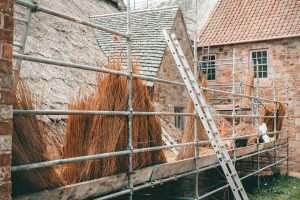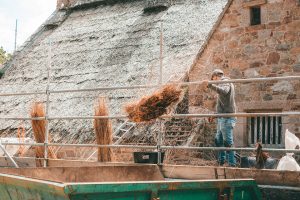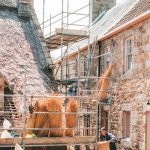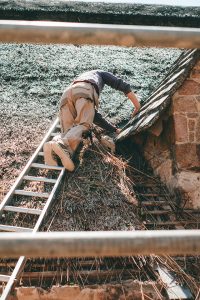
The 15th century thatched buildings at Hamptonne Country Life Museum are being rethatched for the first time in 30 years.
Five thatchers from Devon have started work on Hamptonne House and are hoping to rethatch Langlois House as well, subject to the results of a bat survey. Planning permission has been granted for all the work.
The water reed thatch on both buildings has been in place since the early 1990s and was in urgent need of replacement. The thatchers were due to visit the Island last year but were delayed by the Coronavirus pandemic. They are replacing the reed with straw, which is the material that would have been originally used on the roofs.

Chris O’Connor, Jersey Heritage’s Head of Property, said: ‘Although the ridges that cap the top of the thatched roofs have been replaced as part of the maintenance programme, the main body of thatch on both Hamptonne and Langlois Houses has reached the end of its natural life and is in desperate need of attention. We have had to carry out a number of emergency repairs over the past 18 months so are relieved that the team from TJ Thatchers, who were originally due over last spring, have finally been able to make it over to Jersey.
‘These buildings have survived four centuries and maintaining the thatch is an important part of ensuring their future. It protects the buildings and the collection pieces inside, as well as adding to the lovely rural ambience at Hamptonne Country Life Museum.”
There are only a handful of thatched buildings in Jersey and it is a rarity to see rethatching taking place. While the thatchers are at work over the next few weeks, the south courtyard at Hamptonne is closed to visitors, as are Hamptonne and Langlois Houses. The calves have been temporarily returned to their farmer. However, the north courtyard that visitors enter as they arrive at Hamptonne remains open and offers an ideal viewing spot to watch the thatchers at work.
‘The piglets, which are housed behind Langlois House, remain at Hamptonne and can be visited. The garden, meadow, orchard and play area are all open to the public as usual.
Thatching is a traditional roofing method that has been passed down from generation to generation. The craft involves building a roof with dry vegetation, such as straw, water reed, sedge, rushes, heather or palm branches. These materials have been used for centuries as a way of shedding water away from the inner roof.
Since the bulk of vegetation stays dry and is densely packed – trapping air – thatching also functions as insulation. The thatch is tied in bundles, laid on beams and pegged in place. Good thatch does not require frequent maintenance

Jersey, Guernsey, Sark and Alderney share a common thatching heritage among themselves and with their French neighbours, especially those in Brittany. There are also links to mainland Britain.
During the mid to late Middle Ages (late 15th to early 16th Centuries), Europe recovered from the Black Death plague and England and France recovered from the Hundred Years War. A time of peace and prosperity resulted and this is when thatch reached some of its highest refinement.
In more recent times, the introduction of the combine harvester along with the short-stemmed wheat varieties had a significant impact on the availability of quality thatching materials (varieties of wheat from medieval England were said to have grown to 6ft tall). The introduction of nitrogen fertilisers also reduced straw’s longevity. In the UK, it is illegal under the Plant Variety and Seeds Act of 1964 to plant older varieties of wheat. These factors all contributed to a massive decline in thatch until the later 20th century, when thatch began to increase again.





